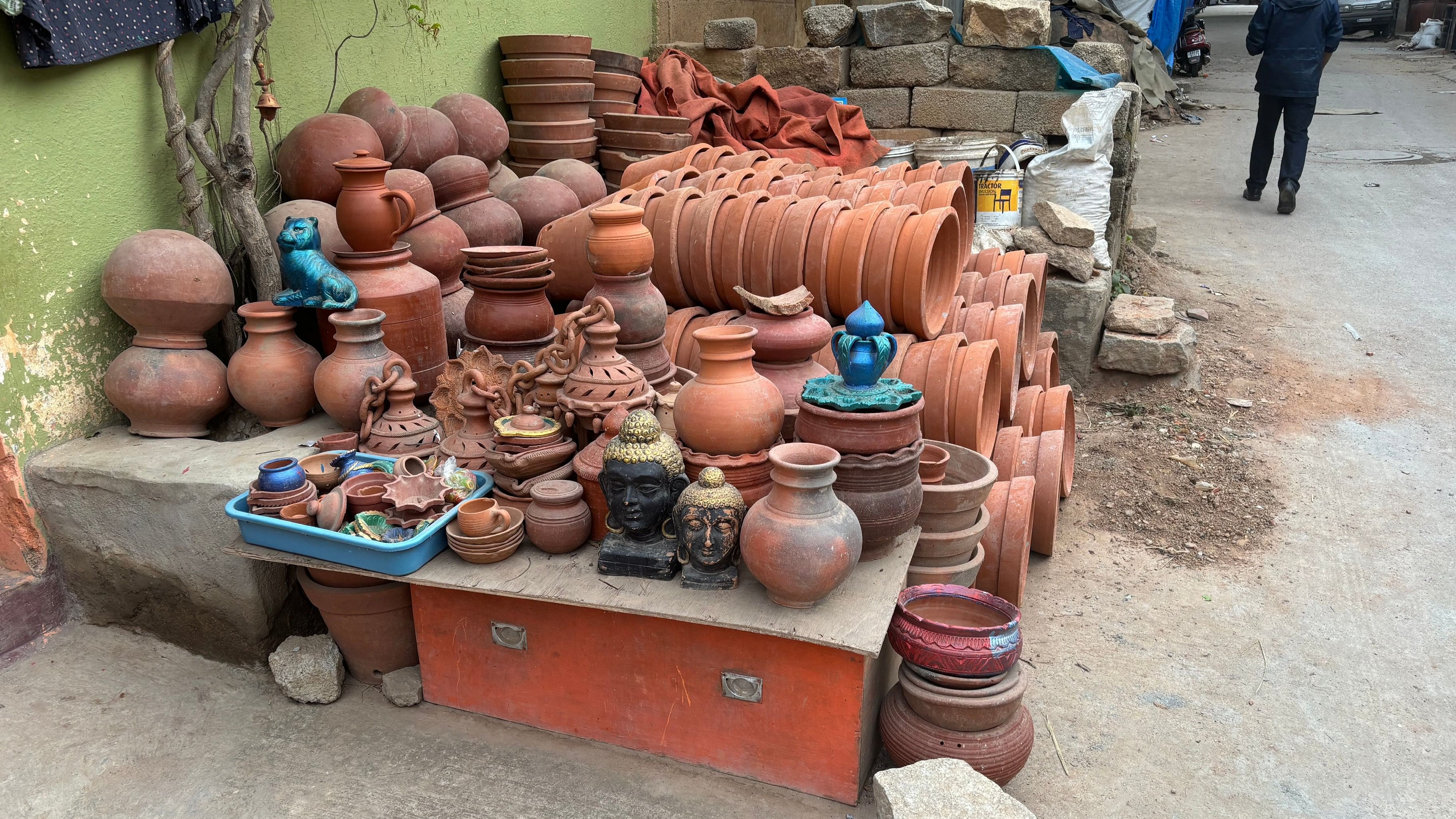
A potter at the wheel; a display of finished products at Pottery Town in Bengaluru.
Photos by author
For decades, artisans across Karnataka have been skillfully shaping clay into garden pots, kitchenware, diyas and more. As the years go by and demand fluctuates, how many continue to work at the wheel, and how is the community adapting?
Pottery Town, tucked away in the heart of bustling Benson Town in Bengaluru, exemplifies this reality. For nearly a century, this enclave has been home to the Kumbara community — skilled artisans who are carrying forward a tradition passed down through generations. But today, the clinking sound of the potter's wheel is fading, as modernity threatens to erase a way of life that has stood the test of time.
Once thriving, the demand for handcrafted clay pottery has sharply declined, having been replaced by cheaper alternatives like melamine, plastic, and ceramic.
For the younger generation of potters, careers in technology or service industries are more promising. “The current generation is moving on to other jobs,” says G Rajashekar, a state award winner in pottery-making and president of the Kumbara Kara-Kushala Kaigarika Sahakara Sangha.
Pictures from Pottery Town.
Photo by Shobhana Sachidanad
“Pottery is all we know, but the market is shrinking. The challenges are manifold. The most essential resource is clay, but due to the presence of pollutants in the lake beds near the city, we are forced to source it from distant lakes, adding to transportation costs. We have to pay Rs 1,200 for a truckload of clay from Hoskote, apart from being charged commercial rates for water and electricity too," he adds.
Pictures from Pottery Town.
Photo by Shobhana Sachidanad
Originally established in 1926, Pottery Town was founded when 40 families of artisans migrated from Tamil Nadu and Andhra Pradesh following the construction of Bengaluru’s first railway line. Over time, the community grew, and today, nearly 100 families live on the land, which was originally allotted to them by the British.
Pictures from Pottery Town.
Photo by Shobhana Sachidanad
“Apart from festive idols, we have moved towards year-long commercial production of tea cups and earthenware for restaurants in the city, as this offers us a regular source of income," says Rajashekar. Artisans also struggle to get bank loans and subsidies to keep their businesses afloat, he adds.
Pictures from Pottery Town.
Photo by Shobhana Sachidanad
New avenues
Just a street away, Balaraj is busy throwing clay onto his lathe. He confesses he is a “late bloomer” in learning the craft. Having been in the business of selling pottery for decades, he finally decided to learn the craft and sell his creations. "I am happy I was able to learn this skill in my 40s. I am now teaching my children the art," he adds.
Pictures from Pottery Town.
Photo by Shobhana Sachidanad
Over generations, many potters have branched off into other professions. But with the resurgence in earthenware due to an increasing shift towards eco-friendly and sustainable products, Kumbaras who were in other professions have begun to pick up the craft to meet the rise in demand. The potters of this locality in Bengaluru now churn out two to three lakh eco-friendly cups a month to cater to the growing demand.
Pictures from Pottery Town.
Photo by Shobhana Sachidanad
In fact, this is what led residents of Pottery Town, Aruna and her husband Dinakaran, to start a manufacturing unit to sell planters to architects and interior designers. Raksha Seth and her three friends, who have been regulars at the Dinakarans’ store, feel the sculptures and planters here are reasonably priced and the quality, exceptional. Raksha often recommends this part of the town to her friends for a heritage walk. She believes supporting the artisans by buying their wares directly can make a lot of difference to the community.
When sales slumped during the pandemic, Suresh, a Kumbara, and others thought of reaching out to a regional social media influencer who had 12 lakh subscribers. They had heard of cafes offering pottery classes for a fee, and thought they could also tap into this space, says Suresh. They soon received enquiries for pottery classes and are sharing their skill and lathes with those interested in learning the craft.
Pictures from Pottery Town.
Photo by Shobhana Sachidanad
n other parts of the state too, there is hope, as Vijendra Singh, principal of the Central Village Pottery Institute in Khanapur, Belagavi, maintains that he has seen a consistent induction of students and enthusiasts, who have continued to pursue pottery even after completion of their courses by either opening their studios or holding workshops. He believes that the quality of clay and easy availability of the resource is what has helped the skill thrive in this part of the state.
Rekha Kumbara, who has worked as a potter in Khanapur for the past 25 years, says that clay is actually free for them, because farmers are happy to allow the Kumbaras to make good use of the clay that is cleared from their farmlands.
Veeresh, whose father has been a potter for decades in Mugad in Dharwad, adds that although the number of artisans has come down over the years, those still in the profession are reinventing their creations to stay relevant.